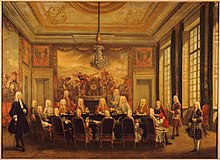Régence
Régence ( French for " reign ") denotes both a short political period in France and the art style of the same time. The former denotes the years between 1715 and 1723, in which the regent Philip of Orléans during the minority of King Louis XV. headed the government in France. The art style spans roughly the years between 1715 and 1730 and means a transition form to the Rococo .
politics
When Louis XIV died in 1715, 54 years of absolutist rule came to an end, which had shaped France both politically and culturally. Even before his death, he had given his nephew, Philip of Orléans , the power of government for the period in which his great-grandson Louis XV. was not yet of legal age. When Louis XIV died, France was the most powerful state and cultural center in Europe. On the other hand, with a new king, the time for new directions in politics and culture had dawned.
Philip of Orléans maintained a more open, but also weaker style of government than his uncle: he promoted the parliaments , was against censorship and ordered the reprint of books that had been banned under his uncle's rule. He also promoted the fine arts and was himself a great art connoisseur. He was also known for the excesses at his lavish parties, which he held at his court at the Palais Royal in Paris .
He followed his uncle's political rethinking by entering into an alliance with Great Britain , Austria and the Netherlands , but waged a successful war against Bourbon Spain that created the conditions for a European peace. Between 1716 and 1720 he tried to use the financial system of the Scottish economist John Law to reduce the enormous national debt, but this failed and led to one of the first major financial and speculative crises.
Art style


Since Philip of Orléans saw no reason to move the center of his life to the Palace of Versailles , where his uncle had resided, the aristocratic families who had been close to Louis XIV, but did not want to go to the court of Philip of Orléans, looked for them for a balance they found in privacy. Many turned their backs on Paris and retired to their country estates. On salon evenings one met writers, poets and philosophers, made music and sought spiritual stimulation as well as elegant diversion. Intimate subjects and fine colors, such as those of Antoine Watteau and his teacher Claude Audran III , enjoyed great popularity. Both made the floral tendril shapes and wave motifs popular, which would later become the style of the Rococo . The artisans Thomas Germain and Gilles-Marie Oppenord , the latter's draftsman for the regent, were influenced in their work by northern Italian asymmetrical and irregular cartouches. The imaginative ornamental prints Jean Bérains , inter alia, of the grotesque of the Renaissance were inspired, also influenced the entire decorative arts, not only in France but also in England and much of northern Europe.
In keeping with the spirit of the nobility , the Regency style is particularly evident in interior decoration and furniture design; the exterior of the building remained strongly influenced by the 17th century.
By the cabinetmaker André-Charles Boulle new furniture pieces were popular, as the flat desk ( bureau plat ), the bureau and the low bookcase or the Cabinet ( Bas armoire ). In general, the tables became smaller, more delicate and easier to handle. Console tables became more important and were integrated into the interior decoration, for example by being placed under a mirror and corresponding to its shape. A new type of small toilet or ladies' desk ( Bonheur du jour ) was created for women . Chairs are becoming popular, so-called voyeuses or ponteuses , on which one sat astride in order to watch other parlor participants playing or talking.
The materials used were exotic woods from Asia and Africa that were shipped from the colonies, e.g. B. silk wood, Indian rosewood or amaranth wood . Female masks, monkeys, seashells and bat wings became popular ornaments, as well as palmettes, sunflowers and acanthus leaves. Backgrounds were often checked or decorated with diamonds. Also chinoiserie , which should be even more important in the Rococo were already represented.
The goldsmith Juste-Aurèle Meissonnier became famous in the field of silver work of the Régence , who repeatedly managed to find the perfect balance between asymmetry, dynamism and tension in his innovative designs.
literature
- Noël Riley (Ed.): Crafts & Design. Styles, techniques, decorations from the Renaissance to the present. Seemann, Leipzig 2004, ISBN 3-86502-091-7 .
Individual evidence
- ↑ Cf. Didier Foucault: Histoire du Libertinage. Des goliards au marquis de Sade. Perrin, Paris 2007, ISBN 978-2-262-01833-7 .
- ↑ Noël Riley (Ed.): Crafts & Design. Styles, techniques, decorations from the Renaissance to the present. 2004, p. 114.
- ↑ Noël Riley (Ed.): Crafts & Design. Styles, techniques, decorations from the Renaissance to the present. 2004, p. 79ff.
